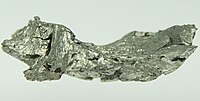
Photo from wikipedia
RATIONALE AND OBJECTIVES Brain deposition of gadolinium following the administration of gadolinium-based contrast agents (GBCAs) was initially reported in 2014. Gadolinium deposition is now recognized as a dose-dependent consequence of… Click to show full abstract
RATIONALE AND OBJECTIVES Brain deposition of gadolinium following the administration of gadolinium-based contrast agents (GBCAs) was initially reported in 2014. Gadolinium deposition is now recognized as a dose-dependent consequence of exposure. The potential clinical implications are not yet understood. The purpose of this study was to determine radiologists' reporting practices in response to gadolinium deposition. MATERIALS AND METHODS An electronic survey querying radiologists' practices regarding gadolinium deposition was distributed by Radiopaedia.org from November-December 2015. RESULTS Our study sample included 94 total respondents (50% academic; 27% private practice; 23% hybrid) from 30 different countries (USA 18%). Fifty-seven (62%) radiologists had observed brain gadolinium deposition on MRI brain studies howerver more than half of these (30 of 57) reported detecting dentate T1 shortening only rarely (<1/month). Among respondents, 58% (52 of 89) do not or would not include the finding in the radiology report; only 12 (13%) report the finding in the impression of their reports. The most common reason for not reporting gadolinium deposition was the risk of provoking unnecessary patient anxiety (29%, 20 of 70). Recent data on gadolinium deposition has led to a reported practice change in 24 of 87 (28%) of respondents. CONCLUSION Recognition of, and attitudes toward, brain gadolinium deposition were inconsistent in this worldwide sample. Most surveyed radiologists do not routinely report dentate T1shortening as a marker of gadolinium deposition. Fear of provoking patient/clinician anxiety and an incomplete understanding of the implications of gadolinium deposition contribute to inconsistencies in reporting.
Journal Title: Current problems in diagnostic radiology
Year Published: 2019
Link to full text (if available)
Share on Social Media: Sign Up to like & get
recommendations!